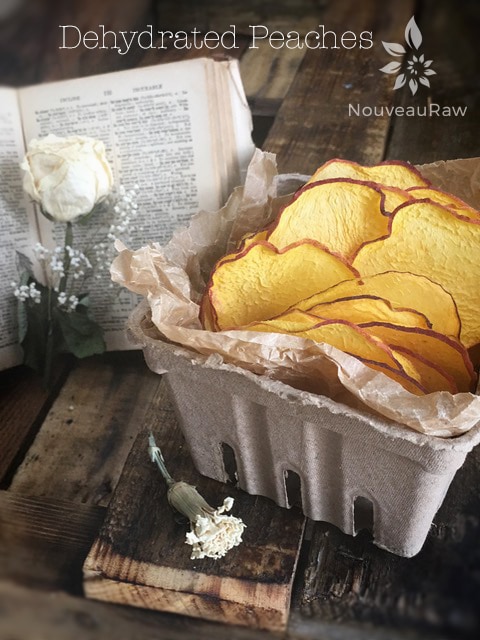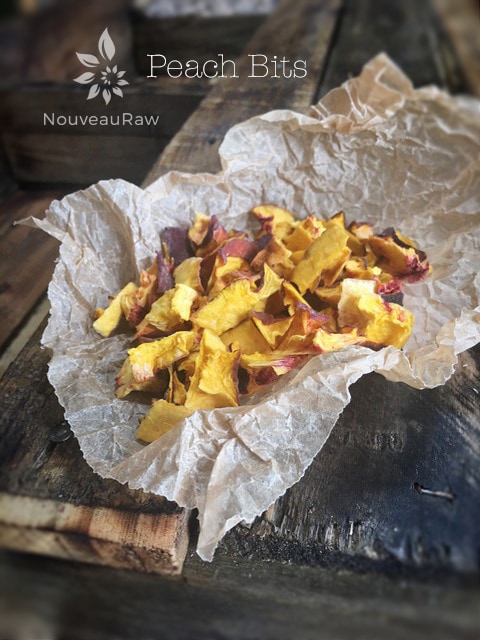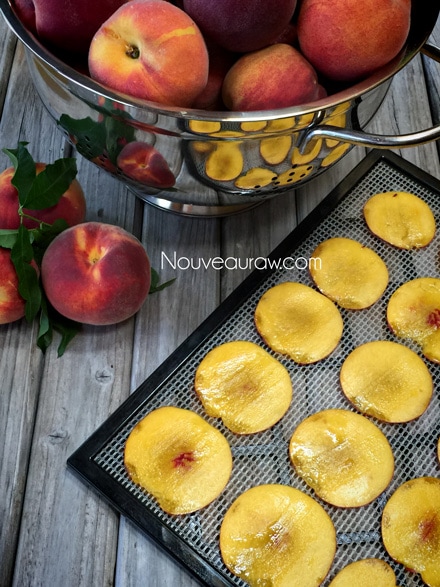Dehydrated Peaches

 Add to favorites
Add to favorites

~ raw, dehydrated ~
If I hadn’t taken this photo myself, I would swear that these “chips” were fried or baked… but they weren’t. They were dehydrated. Eating fresh peaches, unadorned is always the best way to eat them, they are sweet, juicy, and packed full of summer yumminess.
But there are times when we are blessed with such an abundance that you just can’t eat them fast enough. That is when dehydration is a godsend. Each one of these dried peaches is like a time capsule containing the taste of summer, just waiting to be unlocked in the future.
There are several key things that need to take place when dehydrating peaches, which you can read more about below. But right now, I want to talk about the use of a mandolin, tuned the key of D if at all possible.
Ok, not that kind of mandolin but a kitchen appliance mandolin. A good ole sharp knife can do the trick too, but a mandolin will give you accurate, same-sized slices and save lots of time. And who isn’t for that?
Just speaking of mandolins floods me with wonderful memories. Bob and I spent three months in Long Beach WA several years ago. We were blessed by some friends who had a beach house there that was sitting empty, just waiting for us to inhabit it. If you haven’t heard of Long Beach, WA it is one of the only growing beaches in the World and is over 20 miles long.
 They don’t allow any homes or businesses to build on it but you can drive your vehicle out there and enjoy the tides. Well, don’t drive in the tides, ah you know what I mean. haha
They don’t allow any homes or businesses to build on it but you can drive your vehicle out there and enjoy the tides. Well, don’t drive in the tides, ah you know what I mean. haha
Just about every evening, Bob and I would hop in the truck and head down the water. With the tailgate open and pointing in the direction of the sunset we would climb in the bed of the truck and watch the golden ribbons of color dance over the horizon, while we played our mandolins ( the kind you do have to tune ) together. I have so many precious memories such as these with Bob and the neat part is that they continue to happen each and every day. Do any of you play any instruments? I would love to “hear”.
Ok, back to peaches… it is so easy for me to get distracted. hehe For the Peach Chips, I used my mandolin with a slicing blade that cut 1.5 mm cuts. That is pretty darn thin but then my end goal was to create wafer-thin peach chips. Mission accomplished! I know that dehydrating fruits seems like a no-brainer and it basically is, but I encourage you to read through this post because I put together some good tips to help you be successful in your food preserving endeavors. :)
 Selecting Peaches
Selecting Peaches
- Select fresh and fully ripened peaches. Immature peaches lack flavor and color. Drying does not improve food quality.
- Don’t dehydrate bruised and/or mushy peaches, the chips will become see-through, they will be too frail to even peel off the dehydrator tray. Use those peaches for raw peach ice creams or fruit leathers.
Tools for slicing peaches:
Pretreatment
- Treatment Option #1 ~ Ascorbic Acid Pretreatment (vitamin C)
- Why: it is an antioxidant that keeps the fruit from darkening and enhances the destruction of bacteria during drying.
- Where can I find this: Pure crystals usually are available at supermarkets and drug stores.
- How do I use it: Stir 2 1/2 tablespoons (34 grams) of pure ascorbic acid crystals into one quart (1000 milliliters) of cold water. For smaller batches prepare a solution using 3 3/4 teaspoons (17 grams) of pure ascorbic acid crystals per 2 cups of cold water. Vitamin C tablets can be crushed and used (six 500 milligram tablets equal 1 teaspoon ascorbic acid). One quart of solution treats about 10 quarts of cut fruit. Soak the peach slices for 10 minutes, remove with a slotted spoon, drain well and dehydrate. (source)
- Treatment Option #2 ~ Lemon Juice Pretreatment
- Why: Lemon juice may also be used as anti-darkening and antimicrobial pretreatment.
- How do I use it: Mix equal parts of lemon juice and cold water (i.e., 1 cup lemon juice and 1 cup water). Allow the slices to soak 10 minutes, then remove with a slotted spoon, drain well and dehydrate.
Drying Tips
- Arrange the peaches on drying trays in single layers. Don’t overlap because they will stick together.
- The length of time needed to dry fruits will depend on the size of the pieces being dried, humidity, and the amount of air circulation in the dehydrator.
- Also, keep in mind that thinner slices and smaller pieces will dry more quickly than larger ones. So I recommend slicing all the peaches the same thickness so that they dry evenly.
- Drying time can range from 6-36 hours at 115 (F) degrees.
- Testing for doneness — Dry the peaches enough to prevent microbial growth and spoilage. You shouldn’t be able to squeeze any moisture out of the dried fruit. They should be leathery and pliable.
- To test the peaches for dryness, remove a few pieces from the dehydrator, and let them cool to room temperature. When warm or hot, fruits seem more soft, moist, and pliable than they actually will be once cooled. You can remove the peaches when they are more soft and chewy but keep in mind that the more moisture that is left in them, the shorter the shelf life.
Storing
- Pack cooled, dried peaches in small amounts in dry, scalded glass jars (preferably dark) or in moisture and vapor-proof freezer containers or bags. Packaging warm dried peaches can cause moisture in the container which will create a breeding ground for mold.
- Package in small amounts. Every time a package is re-opened, the food is exposed to air and moisture that will lower the quality of the food.
- Label packages with the name of the product, date, and method of pretreatment and drying.
- Tightly seal containers to prevent reabsorption of moisture or entry of insects.
- Store in a cool, dry, dark place or in the refrigerator or freezer. Properly stored, dried fruits keep well for six to 12 months.
- Discard if they have off odors or show signs of mold.
Inside of the peach is a pit and it is semi-flat on one side. To
get the largest, flat slices, we want to slice the peach to
on the two sides that lay flat…. slicing down just until
you reach the pit. See photo below.

Here you see the peach pit laying lengthwise, I sliced parallel
to that. To know which way the pit is laying flat, look for the
crease on the peach that starts where the stem was. It sort of
divides the peach in half. Slice the peach on the two fleshy sides
of that crease. Boy, I hope that makes sense!


© AmieSue.com
Tags: Dehydrated



 Add to favorites
Add to favorites
 They don’t allow any homes or businesses to build on it but you can drive your vehicle out there and enjoy the tides. Well, don’t drive in the tides, ah you know what I mean. haha
They don’t allow any homes or businesses to build on it but you can drive your vehicle out there and enjoy the tides. Well, don’t drive in the tides, ah you know what I mean. haha Selecting Peaches
Selecting Peaches
I haven’t got a dehydrator yet but love looking at your inspiring recipes.
What a coincidence I’ve just bought a mandolin. As I already play the violin it’s fairly easy to transfer the skills from one instrument to another. I also blow my own trumpet but I’m more of an amateur jack-of-all-trades.
Good morning SJ,
I can see where going from violin to mandolin would be easy. I started tinkering with the mandolin, then went to guitar…. ooooh it seemed soooo big after the mando. lol I can’t play well, but we have fun with them. We then got ukuleles. lol Talk about jumping around in sizes. After that, it was conga drum time for me. :) I haven’t tried any wind instruments. Bob tinkers with them. Having music in the home is so warming to me, regardless of the level of skill. Thanks for sharing and have a great day!
It might sound like a no-brainer question, but how do you slice the peaches? The picture you have shows perfectly circular slices. Do you slice one side of the pip and then the other and use whats left for fruit leathers etc?
Plus when i slice juicy things on my mandoline it just gets very slippery and doesnt cut very well. Am I whining? OK I’ll stop now. Love your web site and all the recipes Amie Sue.
Thank you
Hi Madeleine,
I actually covered all of those things in the post… but yes, I used a mandoline to cut the peaches 1.5 mm thick. I slices two sides and use the left over edge pieces in fruit leathers or sauces. And as far as juicy peaches go… yes, you want them ripe but not mushy. Might be good to wipe down the mandolin now and then throughout the process. I noticed mine got wet and full of little peach pieces occasionally. I just ran it under the faucet, patted it dry and proceeded.
Have a blessed day!! amie sue
Hi Ami-sue , I made these peach chips ,however they came out chewy. I dehydrated them about 20 hrs and they did not crisp. I was afraid to dry any longer for fear of bacteria . I followed your instructions except my 1st slices were a bit too thin, more like scraps and they did crisp a bit.I adjusted the mandolin for larger slices, but still thinner than your size. I think I have a crisping deficiency. I also have trouble making sweet potato chips crisp. Which I really wanted to be able to have on hand. I’d appreciate any suggestions .
Thanks much . Non-crispy Christi
Good afternoon Christi,
Mine weren’t “snap” like the sound of a potato chip crispy. I have yet to ever see fruits dry that crispy. The ones that you see in the stores that are really hard like that have usually been either fried or baked in high heat. I have done several different root veggies too and they never get that hard. Sorry that I don’t have any real answers. Semi-soft Amie Sue hehe
Lol! Now I know to lower my crispy expectations ! Thanks !
lol well, if the crispy expectations get lowered just a tad, the other amazing benefits ought to raise other expectations, hehe
Hi ….
Wonder if you can direct me. I put my peach slices into the dehydrator, and had several peach slices left over.
How can I store them, until the 1st batch is done? Is that possible? OMG
Thank you,
Sue
Hello Sue…. so you sliced more than what your machine will hold? The precut ones ought to be fine, just keep them covered and in the fridge. They will produce a little juice most likely, so just drain and pat them dry before drying them . amie sue
Can this be done in a convection oven?
I am sure it can be Judy. I haven’t ever done it though. My suggestion would be to google it and find out from those who have the experience. I would hate for you to ruin it. Have a great day, amie sue
wow. This is wonderful! I notice that you left the skins on, while others recommend removing them. Do you notice the fuzz being chewy? I don’t even eat the skin of fresh peaches as it gives me a mouth reaction.
I am so happy to find your raw site! I am at a rural New Zealand intentional community, where it is now summer and my peach tree is going bananas, I mean peaches. Talk about bumper crop! Even after sharing the wealth I will have more (and HUGE) peaches than I can eat. I moved here from Portland, OR and see you are at Hood River. Small world, aye matey? Thanks for sharing your enthusiasm and love for Raw food.
Hello Aralyn,
I sliced them very thin and didn’t notice an unpleasant mouth-feel or texture due to having the skins left on. If you have reactions to the skins then I would remove them.
I envy your peach harvest. :) Enjoy them while you can! Dehydrating them is a sure fire way to preserve them so they can be long enjoyed for months to come.
Oh wow… that is so neat that you once lived in Portland. I love that city. I hope that your new home in New Zealand has been a wonderful transition. Have a blessed and wonderful weekend, amie sue
Thank you for this information. I have been using a knife to cut my peaches and wondered if a mandolin slicer would help reduce prep time and produce consistent thickness of the slices. You’ve confirmed that it will do both! I was going to continue pitting the peaches first then slicing crosswise. It seems like your method will reduce prep time more than I’d thought possible and make a prettier chip since the peach will be subjected to less handling.
I have been reading mandolin reviews and watching videos for a few weeks and settled on one model. Now I see that it’s the same model that you link to. That is reassuring. But I am confused. The specifications say it comes with 7mm and 3.5mm slicing blades and a “thick/thin reversible slicing blade.” Is the reversible blade the part that allows you to make slices as thin as 1.5mm? In all the demos I watched, they show various thicknesses but never tell the actual measurements.
I was prepared to settle for 3.5mm slices. Now I wonder if it really works for a wider range of thicknesses.
Good afternoon Lisa,
The mandolin works great for making even and thin slices, the key is that the fruit or veggie needs to be firm enough for the machine… mushy peaches wouldn’t work so much.
The unit I have isn’t for sale any more on Amazon… out with the old and in with the new. :P I tried to find out about this unit and came up with what you did. Some people state, “I have sliced a potato so thin that you can almost see through it! Tomato slices, too.” And then others say it only gets down to 1/4″ thick. I researched a few others that get down to 1.5 cm. https://nouveauraw.com/equipment/utensils-gadgets/
Have a wonderful day! amie sue